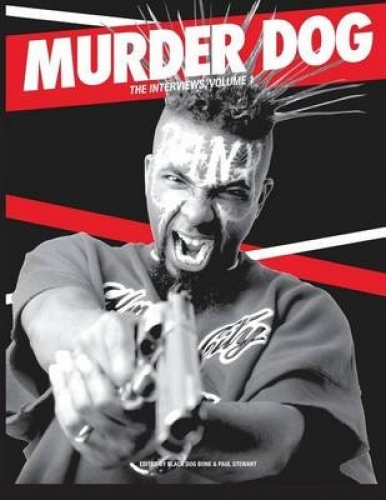A man in black climbs a sun-scorched hill, eyeing eucalyptus trees in the distance. Behind him is a panoramic view of Vallejo, the small Bay Area city he’s called home for decades: There’s the South Side neighborhood, where he launched Murder Dog, the storied gangsta rap magazine, out of his garage on Porter Street. “We’d come here with a car full of guns in guitar cases,” he says of the bluffs. “For photo shoots.”
He’s selected the same location to have his own photo taken, bringing along a duffel bag full of knives and instruments, plus a cardboard box stuffed with fresh flowers. Spirited and spry, he thumbs a hand-drum and veers off trail. In his native Sri Lanka, people describe the 61-year-old raw-foodist as rangda, as in badass, or savage. His kids call him Eric. But most people, unaware of his lives before rap, call him by the name atop Murder Dog’s masthead, Black Dog Bone.
Murder Dog, which published more than 70 issues between 1993 and 2014, was an antidote to the industry-oriented pages of magazines like The Source—elevating regional scenes while hip-hop’s supposed papers-of-record primarily covered artists from the coastal power centers. Its winding, unabridged question-and-answer features amplified voices familiar to readers on the streets or, due to free prisoner subscriptions, behind bars. With a quintessentially Bay Area independent streak, the homespun operation flourished, anticipating the cultural decentralization wrought by the internet.
But Black Dog didn’t want to hike this hilltop to reminisce about Murder Dog’s glory days, and he insists that the scenic Vallejo backdrop is irrelevant: “I don’t want any civilization in these photos.” He likes when nature encroaches on cities, because it offers a glimpse of human depopulation on earth.
Some people know Black Dog as Eric Cope, but this name, too, is invented—a moniker he used amid San Francisco’s post-punk scene of the 1980s. (He refused to tell me his birth name.) Cope was the mercurial frontman of Glorious Din, proprietor of left-field punk label Insight Records, and inquisitive publisher of the fanzine Wiring Dept. Cope championed outlying acts before vanishing from the historical record a few years before the emergence of Black Dog Bone.
So while Eric Cope and Black Dog are the same man, he has long compartmentalized these two periods of his life. His dramatic self-reinventions link typically disparate cultural histories, yet for decades he’s shrouded the connections in secrecy and misdirection. Upon first meeting this writer, expecting to discuss Murder Dog, he was shocked to be confronted with old copies of Wiring Dept. We were at a go-to locale for many of his interviews with rappers through the years—a strip-mall family restaurant in Vallejo, neutral territory in a city where blocks are freighted with meaning.
During that first talk, he wore sunglasses inside; during the next, he removed them. In between these meetings, he flipped his truck on a remote mountainside highway in Northern California. The experience left him shook. Mentioning his mortality, he started mailing me pages of lyrical and digressive longhand notes, paeans to nature and danger. The first one begins, “One mouthful of flames can set the whole world on fire.”

















Speak On It!